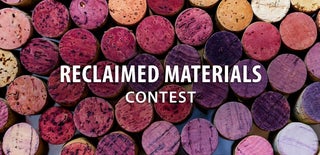Introduction: Half Square Triangle Puzzle
“A mathematician, like a painter or a poet, is a maker of patterns” - British mathematician G.H. Hardy.
Let’s create a geometric and artistic tabletop puzzle with upcycled laminate samples, patterned paper and paint chips. This puzzle is comprised of sixteen square blocks, each of them fashioned like a Half Square Triangle (HST) quilting block. A HST is one of the most basic, versatile and frequently used units in quilting. Essentially, it is a square unit made up of two identical isosceles right triangles that meet along the diagonal of the square. Just like traditional quilt blocks, these puzzle pieces can can be arranged in seemingly innumerable combinations to create symmetric and aesthetically pleasing patterns.
The unexpected intersection of art and mathematics has fascinated man since historic times. Many influential concepts in the visual arts can be directly attributed to mathematics. Conversely, abstract mathematics and physics concepts can often be better explained by visual means. Everyday arts like quilting clearly illustrate how knowledge of symmetry and modular geometry is essential to create visually pleasing quilt patterns.
These articles illustrate how modern artists and educators are seeking to blend together the two diverse fields of art and mathematics:
https://www.uwec.edu/news/news/bring-math-concepts-to-life-through-quilting-2735/
https://www.sciencenewsforstudents.org/article/math-is-muse-for-these-artists
Supplies
- Printed Paper from Old Calendars that are too pretty to throw away or used or new Gift Bags or Gift Wrapping Papers that are gathering dust in your craft closet. Look for seamless repeating patterns to create a cohesive look.
- Free Paint Sample Chips from home improvement stores.
- 16 Square Laminate Samples, acquired from hardware stores, thrift stores or creative reuse stores like ReCraft. Alternative materials: Cereal Box Cardboard, Matte Board or any Thick Cardboard cut into squares.(2.5-3")
- Large Craft Scissors or Paper Trimmer and Multi surface Glue such a Glue-All or Matte Mod-Podge.
Step 1: Create Printed Paper Squares
Create eight square shaped pieces of patterned paper using either Gift Bag Paper, Gift Wrapping Paper or printed Calendar Paper. Make sure the size of the square pieces matches that of the square Laminate Samples or Cardboard cut outs. An ideal size would be a 2.5-3 inch square.
- If using Gift Bag paper, peel the bag open by gently separating the adhered edges. Remove and discard the bag handles. Lay the bag flat on the working surface. Avoiding creased surfaces, cut out squares from usable paper sections
- If a single pattern does not yield eight squares, use two patterns that share a similar colour scheme and can create a cohesive look. Create four square units out of each pattern.
- Cut each square along it’s diagonal to create two half square or right triangles. You should now have sixteen triangle units.
Step 2: Create Paint Chip Squares
1.Pick eight Paint Sample Chips whose colors complement or match those of the printed papers chosen. Create square shaped units from these Paint Chips. Make sure they match the Laminate Sample squares and the Patterned Paper squares in size.
2.Cut each square along it’s diagonal to create two half square or right triangles. You should now have sixteen solid colored triangle units.
Step 3: Create Half Square Triangle Blocks
Use one piece of Laminate Sample or Cardboard square as a base for each Half Square Triangle (HST) unit. Pick a combination of one printed paper triangle and one solid colored triangle for each HST unit/ puzzle block. You should have sixteen such pairs available.
- Glue a pair of patterned and solid triangles to each Laminate or Cardboard base. Take care to align edges as much as possible. The Mod Lodge or multi surface glue would allow a bit of curing time within which the paper pieces can be moved and repositioned.
- Cover the tops of the adhered papers with a coat of glue or Mod Podge so as to seal them. Allow a few hours of drying time.
Step 4: Enjoy Playing With the Puzzle Blocks!
The puzzle blocks are now ready to be arranged in different combinations! The overall goal is to create symmetric designs in a square format that are pleasing to your eye. The finished size of the puzzle should be 10x10 inches to 12x12 inches, depending on individual block size.
Attached below is a reference sheet (printable) that displays 72 designs that can be created by arranging sixteen HST blocks in different ways. These were digitally generated by Mark Jason Dominus using the Perl program suite. More information about the same can be found here:
https://www.plover.com/~mjd/misc/quilt/quilt/
Attachments

Participated in the
Reclaimed Materials Contest














